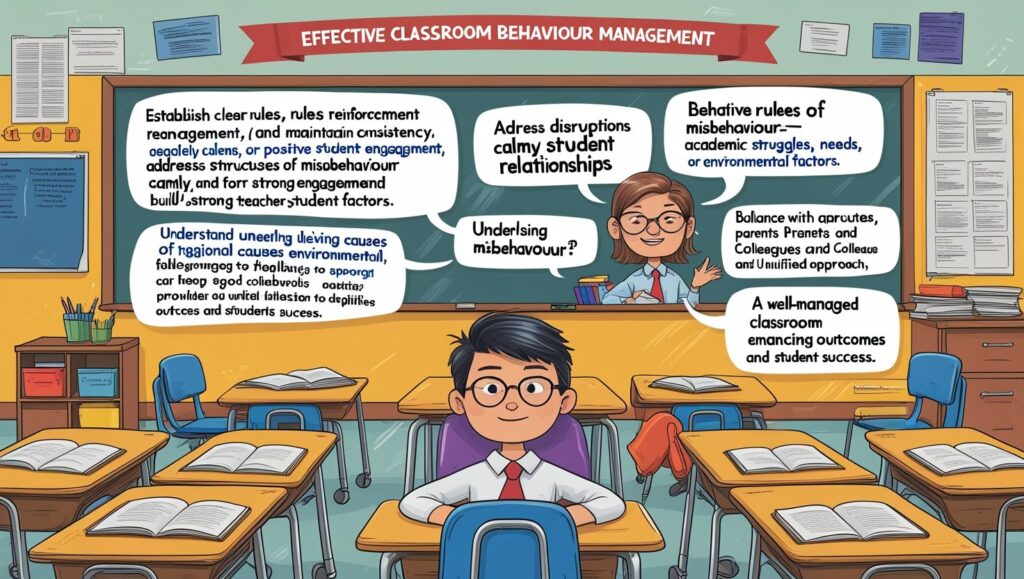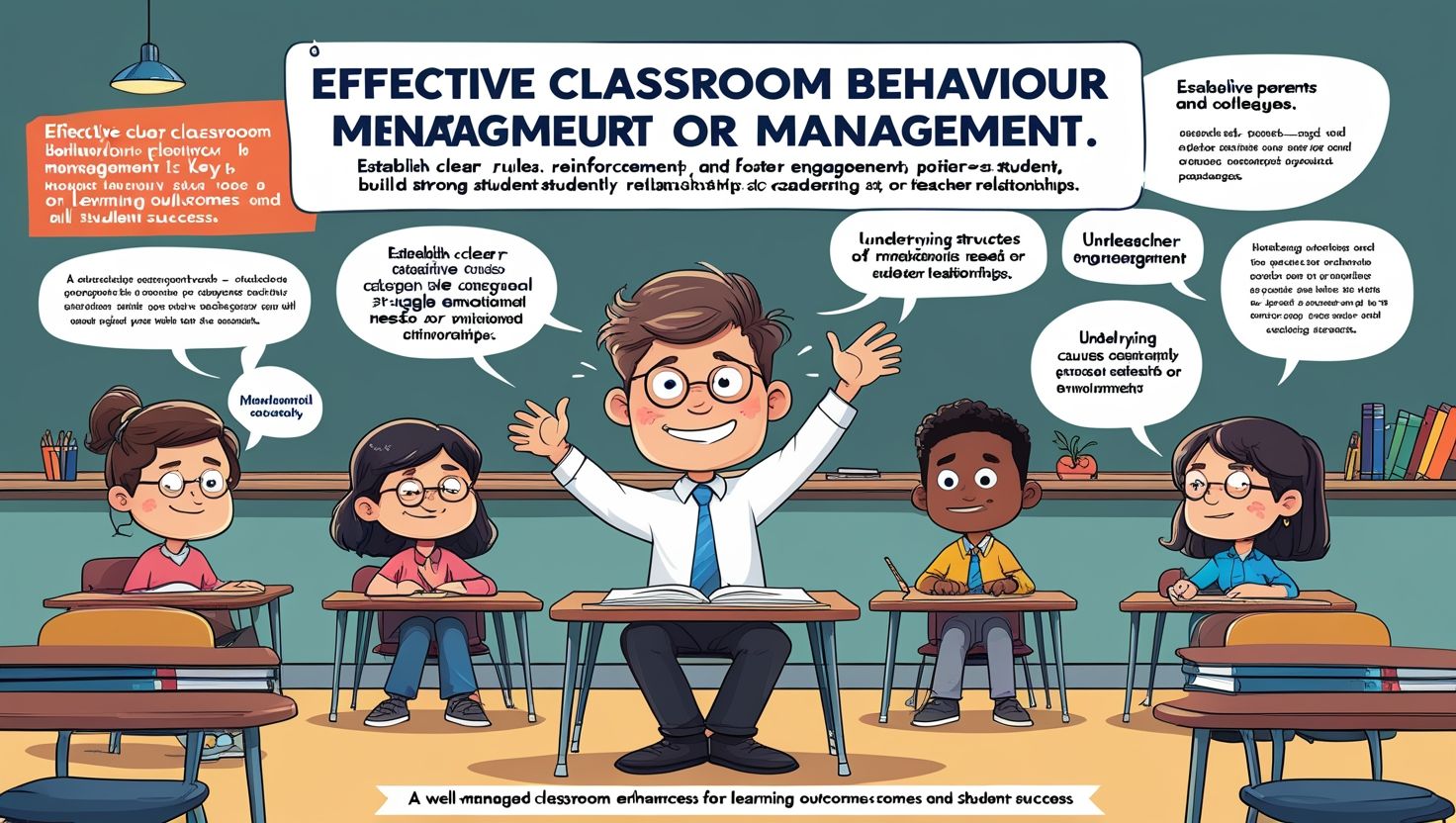Introduction
Classroom Behaviour in Teaching, Classroom behaviour is a critical aspect of effective teaching and learning. A well-managed classroom fosters a positive learning environment, enhances student engagement, and improves academic outcomes. However, managing student behaviour remains one of the biggest challenges for educators, particularly in diverse and dynamic classroom settings.
This article explores the key components of classroom behaviour management, including:
By the end of this article, educators will gain insights into practical strategies for maintaining discipline while promoting a supportive and productive classroom atmosphere.
1. Understanding Classroom Behaviour
Classroom behaviour refers to the actions, interactions, and conduct of students within an educational setting. It includes both positive behaviours (such as active participation, cooperation, and respect) and negative behaviours (such as disruptions, defiance, and inattentiveness).
Effective behaviour management is not just about controlling negative actions but also about encouraging positive behaviours that contribute to a conducive learning environment. Teachers must recognize that behaviour is often a form of communication—students may act out due to underlying issues such as academic struggles, emotional distress, or social challenges.
2. Factors Influencing Student Behaviour
Several factors influence how students behave in the classroom:
A. Individual Factors
- Personality Traits: Some students are naturally more outgoing, while others may be shy or introverted.
- Learning Styles: Students who struggle with traditional teaching methods may become disengaged or disruptive.
- Emotional and Psychological Well-being: Anxiety, stress, or trauma can affect behaviour.
B. Environmental Factors
- Classroom Setting: A noisy, cluttered, or uncomfortable environment can lead to distractions.
- School Culture: A school with a strong disciplinary framework and positive ethos tends to have better student behaviour.
- Home Environment: Family dynamics, socioeconomic status, and parental involvement play a significant role.
C. Teacher-Related Factors
- Teaching Style: Authoritative (firm but fair) teachers tend to have better-managed classrooms than overly permissive or authoritarian ones.
- Classroom Rules and Expectations: Clear, consistent rules help students understand behavioural boundaries.
- Teacher-Student Relationships: Positive relationships reduce behavioural issues.

3. Effective Behaviour Management Strategies
Managing classroom behaviour requires a proactive approach. Below are some research-backed strategies:
A. Establishing Clear Expectations
- Set and communicate classroom rules early.
- Involve students in creating rules to foster ownership.
- Use visual reminders (posters, charts) for reinforcement.
B. Positive Reinforcement
- Praise and reward good behaviour (e.g., verbal praise, stickers, privileges).
- Implement a token economy system where students earn points for positive actions.
C. Consistent Consequences
- Apply fair and predictable consequences for misbehaviour.
- Avoid harsh punishments; instead, use logical consequences (e.g., if a student disrupts the class, they may need to reflect on their actions).
D. Engaging Lesson Delivery
- Use interactive teaching methods (group work, hands-on activities, technology).
- Differentiate instruction to meet diverse learning needs.
E. Proactive Classroom Management
- Monitor the classroom actively (scanning, moving around).
- Use non-verbal cues (eye contact, gestures) to redirect behaviour.
4. The Role of Teachers in Shaping Behaviour
Teachers play a pivotal role in influencing student behaviour through:
- Modelling Respect and Patience: Students mimic teacher behaviour.
- Building Relationships: Knowing students personally helps in understanding their motivations.
- Providing Emotional Support: A supportive teacher can reduce anxiety-driven misbehaviour.

5. The Impact of Technology on Classroom Behaviour
Technology can both aid and disrupt classroom behaviour:
Positive Impacts:
- Interactive tools (Kahoot!, Nearpod) increase engagement.
- Digital behaviour tracking apps help monitor progress.
Negative Impacts:
- Excessive screen time can lead to distractions.
- Cyberbullying and misuse of devices can create behavioural issues.
Teachers must set clear guidelines for technology use.
6. Positive Reinforcement vs. Punitive Measures
Research shows that positive reinforcement is more effective than punishment in shaping long-term behaviour.
- Positive Reinforcement: Encourages repetition of good behaviour (e.g., rewards, praise).
- Punitive Measures: May stop misbehaviour temporarily but can lead to resentment.
A balanced approach is ideal—combining rewards with fair consequences.
7. Addressing Challenging Behaviours
For persistent issues (e.g., aggression, chronic disruption), teachers can:
- Use Behaviour Intervention Plans (BIPs).
- Collaborate with counsellors and parents.
- Implement restorative practices (e.g., conflict resolution circles).
8. The Importance of Consistency and Routines
Students thrive in structured environments. Consistent routines reduce anxiety and prevent misbehaviour.
- Start each class with a warm-up activity.
- Have clear transition procedures.
9. Collaborative Approaches to Behaviour Management
Involving parents, administrators, and colleagues ensures a unified approach.
- Parent-Teacher Communication: Regular updates on behaviour.
- Peer Support Systems: Buddy systems or peer mentoring.
10. Conclusion
Effective classroom behaviour management is essential for creating a positive and productive learning environment. By understanding the factors that influence behaviour, implementing proactive strategies, and fostering strong teacher-student relationships, educators can minimize disruptions and maximize engagement. A combination of clear expectations, positive reinforcement, consistent consequences, and collaborative efforts will lead to a well-managed classroom where all students can thrive.

4 thoughts on “Classroom Behaviour in Teaching”
Comments are closed.